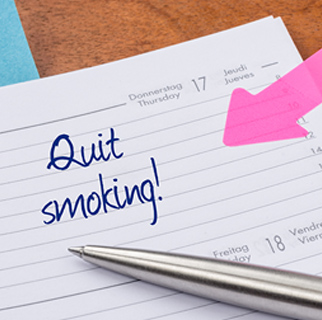Tips for a Successful Quit-Smoking Day

You've done your homework, made your plan, and tossed out all your cigarettes. Now the big day is here. It's day one of your plan to quit smoking. You've probably heard that nicotine withdrawal is unpleasant. And that most people need to quit several times before they reach their goal. But if you can make it through this first day and this first week, when nicotine withdrawal symptoms are at their worst, you'll be on your way to success.
One of the most important things you can do right now is remind the people around you that today is the day you're quitting cigarettes and ask for their help. This might mean asking some people not to smoke around you. Then you won't be as tempted to give in to a craving.
How you might feel today
You may have a range of nicotine withdrawal symptoms today or during this first week. It's not uncommon to have four or more of these reactions:
Cravings for cigarettes (nicotine)
Anger
Frustration
Grouchiness
Depression
Anxiety
Weight gain
Increased appetite
You can reduce these symptoms by using nicotine replacement products. These products can help ease some of the symptoms so that you can focus on the emotional aspects of quitting. They can also increase your likelihood of successfully quitting. Some of these products are over-the-counter (gum, patches, lozenges, and pouches). Others need a prescription (inhalers, nasal sprays). If you use an over-the-counter product, be sure you're using the correct strength based on your smoking history. If your healthcare provider has prescribed nicotine replacement products, use them as directed to help ease symptoms. Bupropion and varenicline are prescription quit-smoking pills that may also be helpful. If your provider suggested these, make sure you understand exactly how and when to take them.
Getting through tough moments
Here are no-cost or low-cost strategies for meeting today's challenges:
Plan a new morning ritual. If smoking was a big part of how you started every day, create new positive habits. This may include making a healthy breakfast from scratch. Ideally, the activity should last an hour or more. It should keep you busy and distracted.
Plan activities. Schedule activities that you enjoy, but that you don't connect to smoking. This helps you to stay busy and not feel bored or frustrated. It's OK to bribe yourself a little bit, too. Reward yourself after you get through the afternoon without a cigarette by going to the movies or getting a manicure.
Lean on others for support. Ask friends and family to help motivate you. Reach out to support groups available both in person and online. Don't be afraid to contact them. You want to create a network of cheerleaders who will keep you on track.
Drive differently. Maybe you used to smoke in your car on your way to work or to the supermarket. You may need to change your route, listen to new music, or find another way to drive without smoking. You might even want to join a carpool or take a train to shake up your daily commute.
Get physical. Taking a walk or jog or doing any kind of physical activity that you really like is helpful. It can reduce feelings of anxiety, anger, frustration, and stress that are often part of nicotine withdrawal.
Fidget. You may have liked the feeling of a cigarette in your hand. If so, find a small object that you can play with instead. This might be a paperclip, pencil, or even a squishy stress ball.
Keep your mouth busy. Try chewing sugar-free gum, sucking on hard candy, or snacking on fruits and veggies whenever you get a craving. Have all these choices handy at all times.
Take a deep breath. Do deep breathing exercises as often as you need them to ease stress. Every time you exhale, remind yourself that the urge to smoke will pass.
Seek out smoke-free distractions. Take advantage of public smoking bans by enjoying smoke-free places in your community. Enjoy the fresh air filling your lungs.
Create a plan to manage triggers. You probably have favorite times and places to smoke. Or certain stressful (but predictable) events that make you want to light up. Plan your day so that you stay away from as many of your trigger situations as possible. Have a substitute activity you can do when a trigger is unavoidable. This could be drinking a glass of water instead of smoking during scheduled coffee breaks.
Cut back on alcohol. Alcohol weakens your resolve to follow a number of healthy lifestyle choices. And it also often acts as a trigger for smoking. Stay away from any specific drinks you used to enjoy with a cigarette.
Distract yourself. If you have extra time on your hands, keep those hands busy. Find an interesting book or magazine to read, or a puzzle to solve.
Know key contacts. If you have a weak moment, get encouragement so that you don't reach for a cigarette. Call a friend or loved one, or use these resources:
CDC Quitline 800-784-8669
American Lung Association HelpLine and Tobacco QuitLine 800-586-4872, press 2
Smokefree.gov Quitline 877-448-7848
Connect with us:
Download our App: